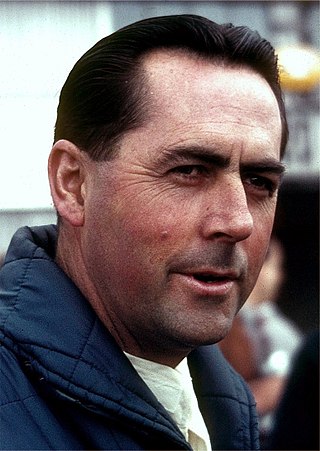
Sir John Arthur Brabham was an Australian racing driver who was Formula One World Champion in 1959, 1960, and 1966. He was a founder of the Brabham racing team and race car constructor that bore his name.

The Cooper Car Company is a British car manufacturer founded in December 1947 by Charles Cooper and his son John Cooper. Together with John's boyhood friend, Eric Brandon, they began by building racing cars in Charles's small garage in Surbiton, Surrey, England, in 1946. Through the 1950s and early 1960s they reached motor racing's highest levels as their mid-engined, single-seat cars competed in both Formula One and the Indianapolis 500, and their Mini Cooper dominated rally racing. The Cooper name lives on in the Cooper versions of the Mini production cars that are built in England, but is now owned and marketed by BMW.

Formula Two is a type of open-wheel formula racing category first codified in 1948. It was replaced in 1985 by Formula 3000, but revived by the FIA from 2009–2012 in the form of the FIA Formula Two Championship. The name returned again in 2017 when the former GP2 Series became known as the FIA Formula 2 Championship.

Formula Three, also called Formula 3, abbreviated as F3, is a third-tier class of open-wheel formula racing. The various championships held in Europe, Australia, South America and Asia form an important step for many prospective Formula One drivers.

Peter Jeffrey Revlon Revson was an American race car driver and heir to the Revlon cosmetics fortune. He was the Can-Am Champion for the 1971 season, and finished fifth overall in the World Drivers' Championship for both the 1972 and 1973 Formula One seasons.
Ian Ewart Raby was a British racing driver from England. He participated in 7 World Championship Formula One Grands Prix, debuting on 20 July 1963 in the British Grand Prix, where he retired on Lap 60. He scored no championship points. He was a garage-owner in Brighton, Sussex trading as Empire Cars Ltd. As a privateer he came to Formula One late in life.
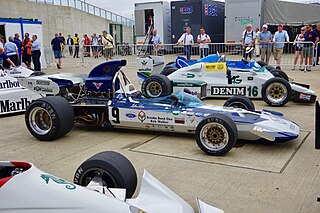
John Maxwell Lineham Love was a Rhodesian racing driver. He participated in 10 Formula One World Championship Grands Prix, debuting on 29 December 1962. He achieved one podium, and scored a total of six championship points. He also won the 1962 British Saloon Car Championship, now known as the British Touring Car Championship. All but one of his Formula One entries were in races held within Africa, either as championship or non-championship rounds.

Richard James David "Dickie" Attwood is a British motor racing driver from England. During his career he raced for the BRM, Lotus and Cooper Formula One teams. He competed in 17 World Championship Grands Prix, achieved one podium and scored a total of 11 championship points. He was also a successful sports car racing driver and won the 1970 24 Hours of Le Mans race, driving a Porsche 917, the first of Porsche's record 19 victories at the famous race.
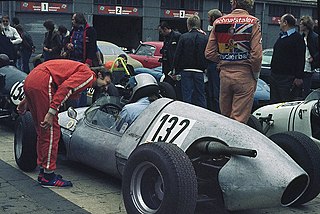
Formula Junior is an open-wheel formula racing class first adopted in October 1958 by the CSI. The class was intended to provide an entry level class where drivers could use inexpensive mechanical components from ordinary automobiles. The idea to form the new class came from Count Giovanni "Johnny" Lurani, who saw the need of a class for single-seater racing cars where younger drivers could take their first steps. It is often speculated that this class was founded as a reaction to Italy's lack of success in the 500 cc Formula Three, and although Italian marques dominated the first year of the formula, they were soon overtaken by British constructors.
The British Formula Three Championship was an international motor racing series that took place primarily in the United Kingdom with a small number of events in mainland Europe. It was a junior-level feeder formula that used small single seater Formula Three chassis. Its final official title was the Cooper Tires British Formula 3 International Series. Notable former champions included Jackie Stewart, Emerson Fittipaldi, Nelson Piquet, Ayrton Senna, Mika Häkkinen, Rubens Barrichello, Takuma Sato, Daniel Ricciardo and Hélio Castroneves.
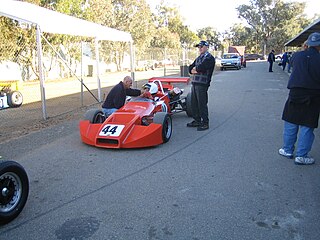
Cheetah Racing Cars was a prolific Australian manufacturer of race cars. The cars were almost solely designed, engineered and constructed by Brian Shead in a small factory at the rear of his home in Mordialloc, a suburb of Melbourne, Australia.

Bowin Cars was an Australian designer and manufacturer of motor racing cars from 1968 to 1976. The company was founded by John Vincent Joyce (1938–2002), a successful designer and builder of racing cars and in later years gas appliances incorporating Low NOx Technology.
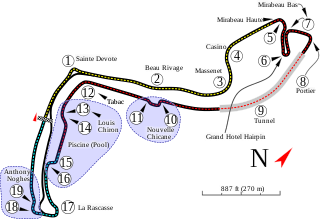
The Formula One Monaco Grand Prix has had a support race in many of its editions, the longest running of which was the Monaco Grand Prix Formula Three, held each year from 1964 to 1997, and again in 2005. It replaced the Monaco Grand Prix Formula Junior. The Formula Three race was replaced by Formula 3000 for 1998, which would then become the GP2 Series and then the Formula 2.
T56 or T-56 may refer to:
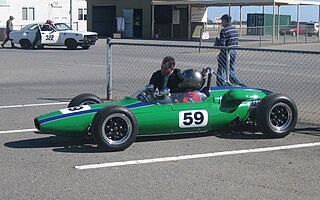
The Cooper T59 was the third series Formula Junior racing car produced by the Cooper Car Company, designed for the 1962 season. Similar in layout to the T56, the T59 was five inches narrower and one and half inches lower than its predecessor. A semi-reclining seat position was adopted for the driver. The chassis frame was stiffened up and the front and rear roll centres raised. T59s were supplied with either Ford or BMC 'A series' engines.

The Cooper T65 was the fourth series Formula Junior racing car designed by the Cooper Car Company for the 1963 season, the final year of Formula Junior. Subsequently, it was available in Formula Two and Formula Three versions. At least one car was built with Hydrolastic suspension but this was not found to be suitable for racing. The T67 was even narrower than its T59 predecessor. T65s and T67s were again supplied with either Ford or the BMC 'A series' engines.

The Cooper T52 was the first series of Formula Junior racing cars produced by the Cooper Car Company, built for the 1960 racing season. Its chassis frame comprised four longitudinal tubes with hoops at the cowl and behind the driver. Unequal length A arms supported the car with coil springs at the front and a transverse leaf spring at the rear. BMC provided the power-plant with the 'A' series engine married to a Citroën box. John Surtees debuted on four wheels in a Cooper T52 at Goodwood in March 1960 when he came second to Jim Clark. The T52 was often outpaced by the Lotus 18 but Henry Taylor managed to win the prestigious Monaco Cup and the Albi Grand Prix driving a MKI Formula Junior T52.

The Brabham BT2 is an open-wheel racing car made by Brabham in 1962.

The Cooper-Bristol, formally called the Cooper Mk.I or the Cooper T20, is a Formula 2 racing car, built, designed, and developed by British manufacturer Cooper Cars in 1952.
Rodney Frederick Banting was a British racecar driver who won the 1964 BRSCC British Formula 3 Championship.
















